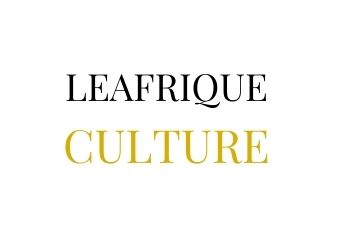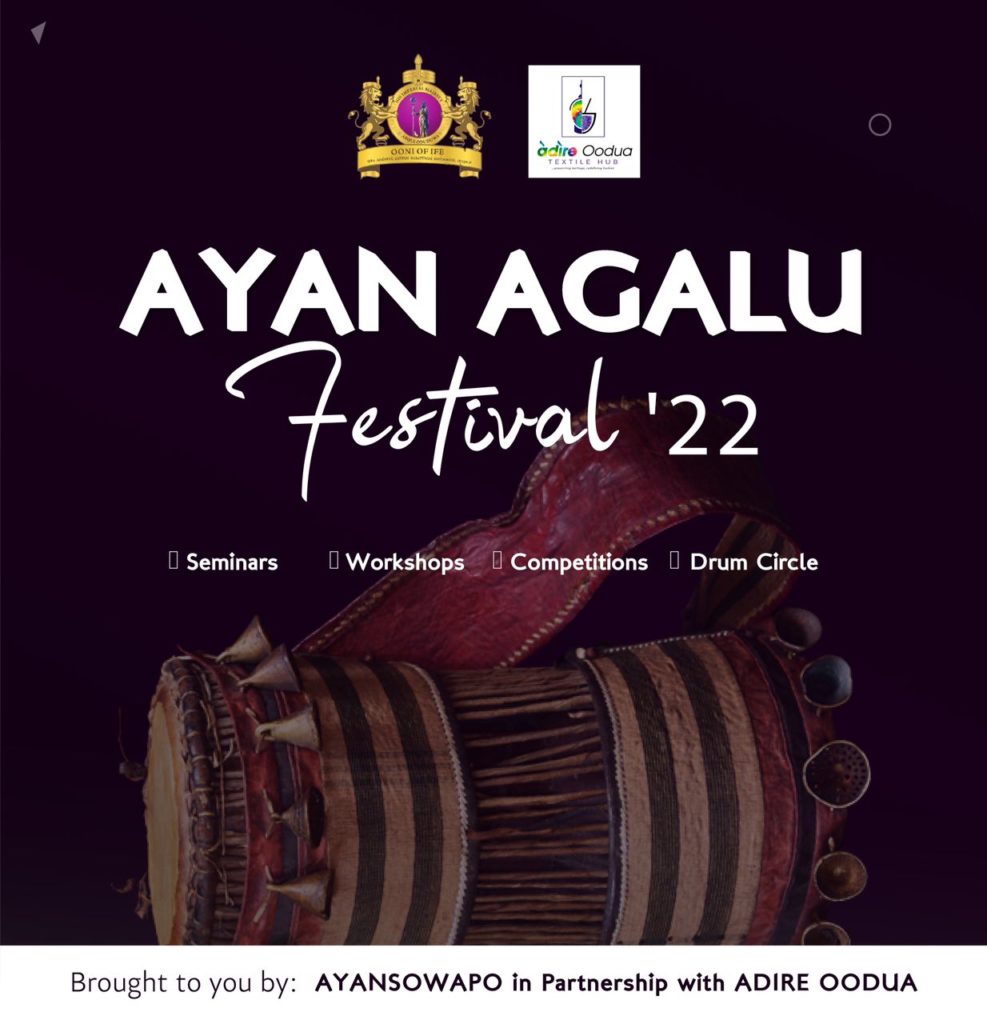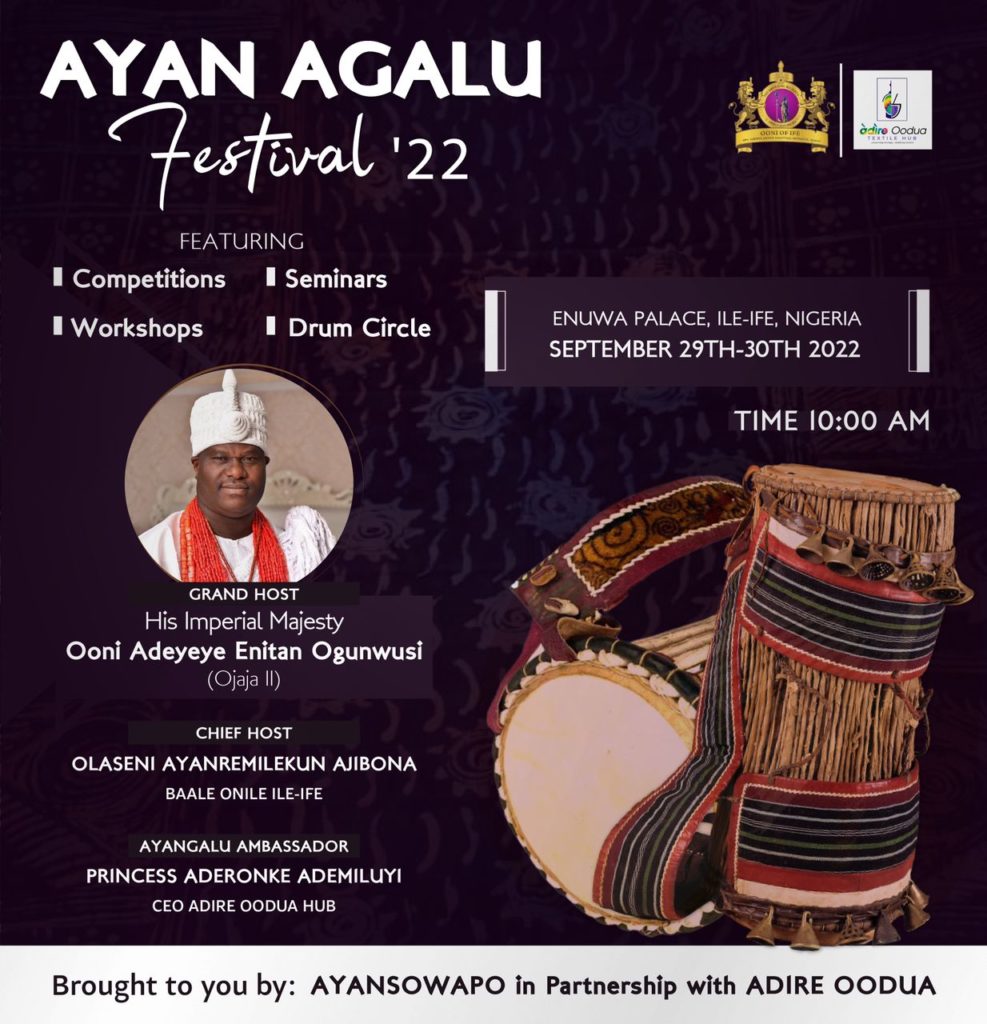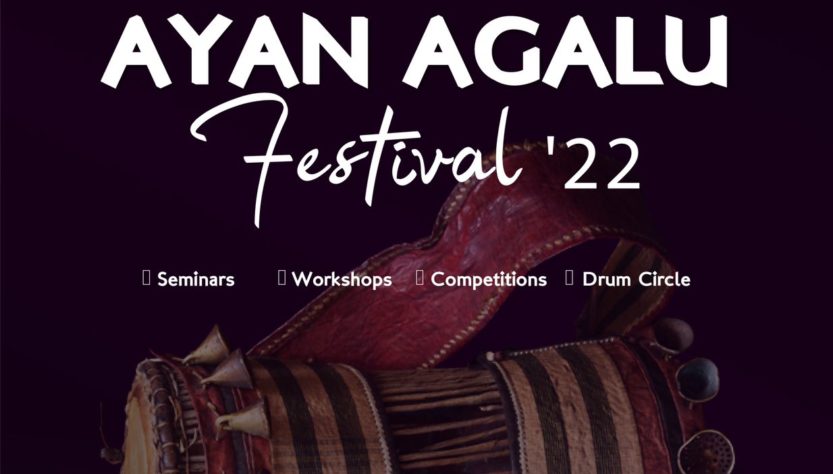

AYAN AGALU
FESTIVAL 22
Redação Le Afrique
Leitura em Português e Inglês
Mais um roteiro cultural é turístico na Nigéria. O Festival AYAN AGALU, também conhecido como Festival do Tambor, está sendo apresentado por Sua Majestade Imperial Ooni Adeyeye Enitan Ogunwusi Ojaja II O Rei de Ifé. Para quem ainda não conhece o evento cultural ele é, em comemoração à Ayan Agalu a Divindade Patrona da Bateria, inspirada em Olodumare. Ela foi a primeira a inventar o tambor falante como meio de comunicação.
AYAN AGALU é o que os africanos chamam de divindade padroeira da percussão enquanto é considerado como o Ana pelos cubanos. Ayan era conhecido como o Orisa do Tambor e a boa música originou-se de Atiba em Ile ife. Ayan é popularmente descrito como o espírito da bateria. Em qualquer lugar que o tambor tenha som, será apropriado supor que o Orisa do Tambor e música Ayan está por perto. Os tambores para o povo iorubá e para os africanos em geral são um aspecto essencial da sua cultura. Esses tambores incluem; Adade, Bata, Sekere, Sakara, Gangan, Agahu, Dundun e Djembe, entre outros. Esses tambores na África são usados para culto religioso, como meio de comunicação com os Reis, em festivais etc. Por isso, é obrigatório celebrar o Ayan como manda a tradição. Além disso, apelando ao mesmo para ter uma conexão em cada tambor com suas forças espirituais.
Os Africanos e Ayan
A religião indígena africana tem sua influência na cultura e na comunidade de seu povo. A crença religiosa do povo dá importância ao espírito e unifica a relação dos ancestrais com a divindade. Isso é significativamente identificado em sua religião e sua relação com o espírito que geralmente são considerados deuses e deusas. Estes explicam ainda que a relação entre humanos e ancestrais ou o Deus superior continua existente.
Cada som da bateria é significativo e fala a língua de Ayan. Isso provoca a utilidade do tambor em canções, orações, poesia, religiosa, anúncio, louvor a líderes e ancestrais, cumprimentos e até piadas.
A música para os africanos ocidentais está permeando e sua utilidade não pode ser subestimada. Olhando através dos usos da música no mundo, ela é uma terapia essencial para o ser humano e também tem propósitos bastante significativos. Para o africano tradicional, a música é a própria vida desde o nascimento até a idade adulta. A música é cantada para crianças e isso é feito para expô-las à influência da música. Uma criança pode estar sob a influência da música quando é usada para atraí-la para dormir ou fazê-la parar de chorar. As mães estão sobrecarregadas com essa responsabilidade com o ato da boa música. A música cantada para bebês é feita com alguns passos de dança dando visibilidade ao seu ritmo. Esses bebês crescem com esse conhecimento da música e não hesitariam em fazê-lo nesse padrão com vários passos de dança, conforme aconselhado. Esse aprendizado não era formalmente feito como é hoje. Eles foram observando, imitando e ouvindo. Isso ajuda a criança a encontrar seu nicho na cultura. Acredita-se que as crianças sejam as progenitoras da cultura e têm a responsabilidade de fazer parte do que faz a cultura e as tradições. Cantar, dançar e batucar são aprendidos com todos os significados ligados a eles para tornar todos um membro participativo da sociedade.
O ESPÍRITO DA BATERIA
AYAN AGALU
A importância do tambor é bastante forte, para os africanos ocidentais e tem diferenças na ordem da importância. Essas importâncias podem ser espirituais, culturais, de beleza, e outros valores tradicionais. Ou seja, para eles tudo o que existe, tem uma importância para tudo.
Adade é geralmente referido como o rei dos tambores e como o próprio nome sugere, usamos a coroa. A utilidade deste tambor pode ser classificada ritualmente e, é regiamente significativa. É conhecido como um tambor tradicional feito especialmente para Alaafin de Oyo, a divindade real de Oyo. Este tambor reside em torno do ambiente Agunpopo em Oyo porque só pode ser encontrado em um composto de um reino. A existência de Adade pode ser atribuída à sua entrada em Ijakuta Oloyin, o que faz com que seja batido em todos os Jimoh Oloyin (todas as sextas-feiras). Esses dias para o engajamento deste tambor são calculados com base no calendário iorubá de 29 dias.
Os tambores da África Ocidental são comumente chamados de Talking Drums em inglês porque, ao contrário de todos os outros tambores ele fala e, é usado para comunicação. Como dito anteriormente, ele é feito de uma árvore, e muitas outras partes do tambor serão discutidas na sessão. Um tambor falante é esculpido em madeira em diferentes formas, conforme específico para o tipo que está sendo feito. Todos os tambores falantes podem ser semelhantes, mas suas diferenças são conhecidas por sua forma. A madeira entalhada é toda coberta com pele e cordões de couro. A pele de cabra é preferencialmente usada para fazer a pele da cabeça do tambor. Os tambores falantes são geralmente com duas peles que são conectadas por cabos de tensão do couro.
Entre os africanos, o tambor falante é chamado de forma diferente e inclui; Dondo, Dyula, Bozo, Lunna e muitos outros. Conclusivamente, as atividades religiosas, rituais e funções sociais entre os africanos não estão completos se os tambores não estiverem presentes. A Nigéria além de ser um país ricamente cultural, mantém até hoje seus costumes religiosos firmes dentro de um clã místico ancestral.
Programação do Festival

Assista e conheça mais sobre o Ayan Agalu Festival.
#nigerianews #festivalayanagalu #travel #culturaafricana #tourpelanigeria #africaturismo
AYAN AGALU
FESTIVAL 22
Another cultural itinerary is touristic in Nigeria. The AYAN AGALU Festival, also known as the Drum Festival, is being hosted by His Imperial Majesty Ooni Adeyeye Enitan Ogunwusi Ojaja II The King of Ife. For those who still don’t know the cultural event, it is, in commemoration of Ayan Agalu, the Patron Divinity of the Battery, inspired by Olodumare. She was the first to invent the talking drum as a means of communication.
AYAN AGALU is what Africans call the patron deity of percussion while being regarded as Ana by Cubans. Ayan was known as the Orisa of the Drum and good music originated from Atiba in Ile ife. Ayan is popularly described as the drum spirit. Wherever the drum has sound, it will be appropriate to assume that the Orisa of the Drum and Ayan music is nearby. Drums for the Yoruba people and for Africans in general are an essential aspect of their culture. These drums include; Adade, Bata, Sekere, Sakara, Gangan, Agahu, Dundun and Djembe, among others. These drums in Africa are used for religious worship, as a means of communication with Kings, at festivals, etc. Therefore, it is mandatory to celebrate Ayan as tradition dictates. Also, appealing to him to have a connection in each drum with his spiritual forces.
The Africans and Ayan
The African indigenous religion has its influence on the culture and community of its people. The religious belief of the people gives importance to the spirit and unifies the relationship of the ancestors with the divinity. This is significantly identified in their religion and their relationship to the spirit who are generally considered gods and goddesses. These further explain that the relationship between humans and ancestors or the higher God continues to exist.
Every drum sound is meaningful and speaks the Ayan language. This provokes the drum’s usefulness in songs, prayers, poetry, religious, announcement, praise to leaders and ancestors, greetings and even jokes.
Music for West Africans is pervading and its usefulness cannot be underestimated. Looking through the uses of music in the world, it is an essential therapy for the human being and also has very significant purposes. For the traditional African, music is life itself from birth to adulthood. The song is sung to children and this is done to expose them to the influence of the music. A child can be under the influence of music when it is used to lure him to sleep or stop him from crying. Mothers are burdened with this responsibility with the act of good music. The sung song for babies is made with some dance steps giving visibility to their rhythm. These babies grow up with this knowledge of music and would not hesitate to do it in this pattern with various dance steps as advised. This learning was not formally done as it is today. They were watching, imitating and listening. This helps the child find his niche in the culture. Children are believed to be the progenitors of culture and have a responsibility to be part of what makes culture and traditions. Singing, dancing and drumming are learned with all the meanings attached to them to make everyone a participating member of society.
THE SPIRIT OF THE BATTERY
AYAN AGALU
The importance of the drum is quite strong for West Africans and there are differences in the order of importance. These importances can be spiritual, cultural, beauty, and other traditional values. In other words, for them everything that exists has an importance for everything.
Adade is often referred to as the King of Drums and as his name suggests, we wear the crown. The usefulness of this drum can be classified ritually, and it is royally significant. It is known as a traditional drum made especially for Alaafin of Oyo, the royal deity of Oyo. This drum resides around the Agunpopo environment in Oyo because it can only be found in a one-kingdom compound. Adade’s existence can be attributed to his entry into Ijakuta Oloyin, which causes him to be beaten at every Jimoh Oloyin (every Friday). These days for the engagement of this drum are calculated based on the Yoruba calendar of 29 days.
West African drums are commonly called Talking Drums in English because unlike all other drums it speaks and is used for communication. As stated earlier, it is made from a tree, and many other parts of the drum will be discussed in the session. A talking drum is carved from wood in different shapes as specific to the type being made. All talking drums may be similar, but their differences are known for their shape. The carved wood is all covered with hide and leather cords. Goat skin is preferably used to make the drum head skin. Talking drums are usually with two heads that are connected by leather tension cords.
Among Africans, the talking drum is called differently and includes; Dondo, Dyula, Bozo, Lunna and many others. Conclusively, religious activities, rituals and social functions among Africans are not complete if drums are not present. Nigeria, in addition to being a rich cultural country, maintains its religious customs firmly within an ancestral mystical clan.


